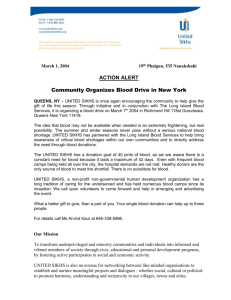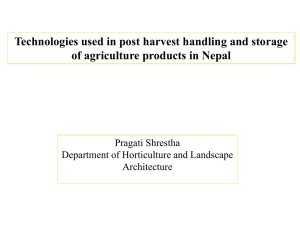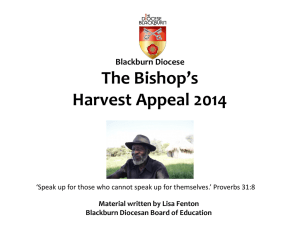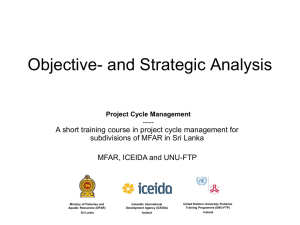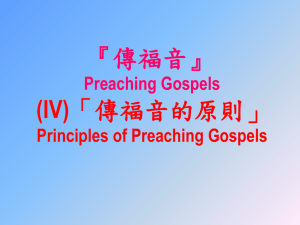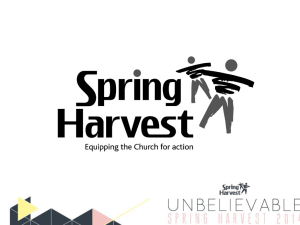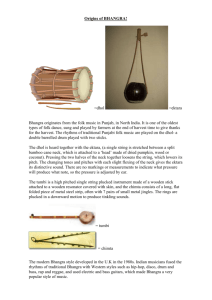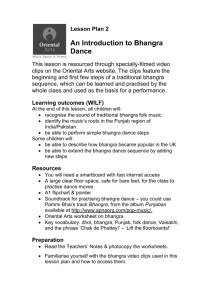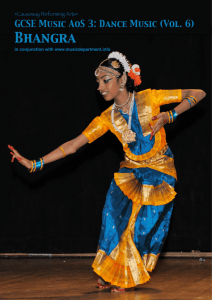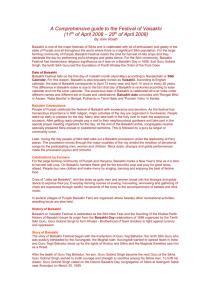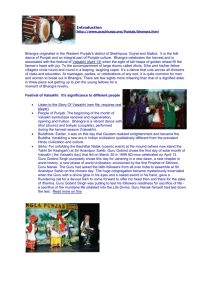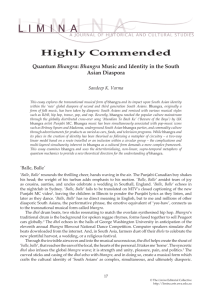Vaisakhi-2014 - Delta Learns
advertisement
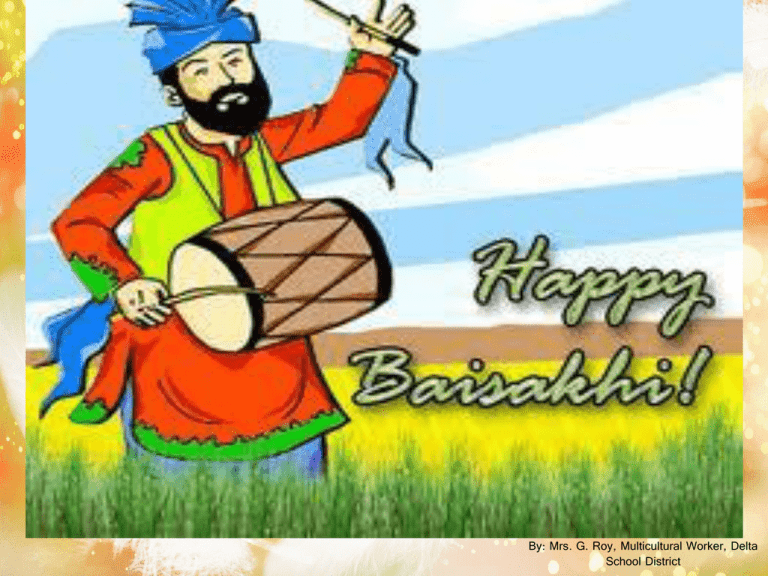
By: Mrs. G. Roy, Multicultural Worker, Delta
School District
The New Year
• India is a land of many festivals. Baisakhi is a
festival held on the first day of the month
Baisakh, which begins on the 14th of April.
• It is a religious festival, harvest festival and new
year celebration rolled all into one.
• This day is the beginning of the Hindu solar
new year. It is celebrated all over the country as
the New Year under different names and with
different rituals.
•
In Punjab, it is celebrated
with lots of enthusiasm
when the crop is ready
for harvesting
In Assam, the young
dress up in their
traditional finery and
dance the night away.
In Bengal, people take
ritual baths and decorate
their houses with Rangoli
(floral patterns).
In Kerala, the celebrations
include fireworks, shopping
for new clothes and
interesting displays called
Vishu Kani.
In the South, people
take out wooden
chariots in a ceremonial
march.
The Harvest Festival
• Harvest festivals are a time
when communities come
together, share and reap
the benefits of the hard
work of the past year and
celebrate the coming of
spring.
• Punjab is an agriculturally
rich province. The main
crop, wheat, is ready to
harvest and sell at
Baisakhi. The harvest
brings prosperity to every
home, and a new business
season begins.
Baisakhi Day, 1699
• Baisakhi also has special meaning for
Sikhs all over the world because, while it
celebrates the harvest, it also celebrates
the day that Sikhs acquired their identity.
• The Sikhs were all given a new name and
a new identity of being a nation by making
them distinctively different in how they
look and behave.
Singh and Kaur
• The men took on a common
surname, Singh ('Lion'), a
reminder to be courageous.
• Women took on the name
Kaur ('Princess'), to
emphasize dignity.
5 K’s – the
Symbols of
Sikhs
Kara – steel
bracelet worn on
the right wrist
Kesh– uncut hair
Kirpan –a small sword
that signifies the duty to
Stand up against injustice
Kachhera – shorts of a
special design
Kangha – a special
comb to keep hair
neat and clean
Turban
• Sikhs groom their long hair
and then tie it in a knot on
the top of their head. They
cover the knot with a long
piece of cotton cloth called a
dastar (turban).
• The turban is a symbol of
respect and honor. It is
disrespectful to ask a Sikh
to remove his turban.
Patka
• Young boys usually start
wearing a turban sometime
between the age of 11 to
16. Before that they tie a
handkerchief over their
knot to keep it intact
(Patka).
• A patka is more practical
for swimming, sports and
to wear to bed.
Nagar Kirtan
• The festival is marked
with a parade through
the streets involving
singing and dancing
(“nagar” means
"town” and “kirtan”
means singing).
• The parade starts and
ends at the Gurdwara. This Year the Nargar Kirtan
will be held on Saturday April
12th in Vancouver and
Saturday April 19th in Surrey
Nagar Kirtan in Surrey
Food
• Free food is distributed by the Gurdwara and by
community members as a community service (sewa).
• The streets of the parade are lined with food stalls and
people passing by are eagerly served.
• The huge amounts of food and meals are usually prepared
starting the night before.
Gatka
• This is a form of
Sikh martial arts
using a variety of
different
weapons.
• Mock duels are
performed during
the parade.
Celebrating
• On Baisakhi, the cold season ends and summer
begins. People shed their thick clothes and
blankets and dress in bright colourful clothes to
celebrate the new season with song and dance.
• All over Punjab farmers are happy because they
have 'gathered in' the wheat, the most important
crop of the season. Now they can perform
Bhangra (folk dance) and sing boliyan (folk
songs).
The folk song goes like this:
• "O, Jatta aayee baisakhi,
Kanka di muk gayee rakhi."
• Hey Farmer! Baisakhi has come,
Guarding of the wheat crops is over.
Bhangra
• The Bhangra is the national folk dance of Punjab.
Traditionally an all-male harvest dance with
vigorous arm movements, it is an expression of the
joy of the Punjabi farmer on seeing the strong and
healthy crops ready for harvest.
Dhol
• The men get together in an
open field and dance to the
beat of the dhol (a drum).
• A drummer carries the dhol
on a strap around his neck
and beats the two heads of
the drum with sticks.
• The dancers usually move
in a circle, dancing in time to
the changing rhythms of the
dhol.
Gidda
• The Gidda is th female equivalent of Bhangra. It is
danced by women and young girls on family and
festive occasions. The girls and women form a circle,
with alternating pairs coming into the middle to
dance to boliyan. The dholki drum provides music
and the rhythm of this dance is set by the distinctive
hand-claps of the dancers.
Boliyan
• The dancers enact verses called boliyan
(rhyming couplets / light-hearted folk poetry).
A boli expresses typical situations and
emotions in village life. Usually a boli is sung
and introduced by one woman, and then the
other girls form a chorus.
Boli Translation #1
Mother oh mother,
What have you done?!
Your daughter is short and your
son-in-law is tall, oh mother!
Boli Translation #2
My mother-in-law is ill tempered she won’t let me wear high heels!
Oh, I will wear high heels too!
Boy(husband), be happy or mad,
I am going to tease your mother!
Sari
• The sari is a “onesize-fits-all 6 metre
length of fabric which
can be tied in over a
100 different ways. It
is worn with a small
blouse and a
petticoat.
Salwar Kameez
• The salwar kameez – a
loose trouser and tunic
- was originally worn by
women in Punjab, but it
has now become the
national dress worn by
women across the
country thanks to its
high comfort factor.
Churidar
• Some women may
wear a churidar
which is similar to
the salwar but
tighter fitting at the
hips, thighs and
ankles.
Lengha
• Other traditional attire
like the lengha (a long
skirt with a blouse) is still
very popular and a must
for ceremonial
occasions like festivals
or weddings.
Chunni / Dupatta
• The chunni or dupatta
is a long scarf that is
worn with most
women’s clothing. It is
a symbol of modesty
and can be worn
around the neck,
across the shoulders,
draped in the arms or
to cover the head.
East meets West
• There is also a
western twist on Indian
fashion with pants or
trousers replacing the
traditional salwar.
Kurta Pyjama
• The Kurta or the top is a
knee length colarless shirt
which is adorned in mostly
white or pastel colors.
But today you will find
Kurtas made out of the
most wonderful and
colorful of fabrics. The
Pyjama is like loose
trousers with a string tie at
the waist.


